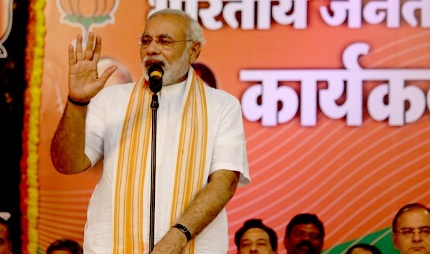India’s Prime Minister Narendra Modi’s energy policy aims for a greener energy mix but will remain heavily reliant on coal
India’s delayed submission of a national climate plan is the result of increasing doubts that the country can meet an emissions intensity target pledged in 2009, plunging future commitments into disarray, thethirdpole.net can reveal.
At the 2009 climate summit six years ago, India undertook to cut its greenhouse gas (GHG) emissions intensity by 20-25% by 2020 compared with 2005 levels, which at the time was viewed by some rich countries as a poor substitute for an overall cap.
But India looks increasingly likely to miss that target, with the Ministry of Environment, Forests and Climate Change told that the current emissions intensity reduction from 2005 levels is 18.6%, with little scope for further improvement.
Earlier this year, various media reported that India would put two pledges on the table in Paris for the post-2020 period – the first based on what the government can do with its own resources, while an alternative proposal would be much more ambitious if the country gets financing and technology transfer from rich nations.
While most rich countries have proposed absolute cuts in emissions after 2020, these are widely regarded as insufficient to avoid runaway climate change. Meanwhile, China and other developing countries such as India will use intensity targets as the centrepieces of their national climate plans (also known as Intended Nationally Determined Contributions) lodged with the UN.
Emissions intensity targets involve reductions of carbon dioxide per unit of GDP, but allow countries to grow emissions without reference to an absolute cap.
China, US, EU, Russia and Japan have all published their national climate plans, heaping the pressure on India – a country critical to a future climate deal – to follow suit soon.
The two-week UN climate summit in Paris starts at the end of November, while a preparatory meeting in Bonn this week is the last opportunity for negotiators to distill a negotiating text.
The likelihood that India will miss its carbon intensity target for 2020 has come as a shock to policymakers in the ministry and in the Prime Minister’s Office (PMO), which is overseeing the preparation of India’s pledge for the period after 2020.
Studying emissions sector by sector of the Indian economy, researchers have concluded there is little scope for increased efficiency in heavy engineering, mining, power generation, cement production, fertiliser production and similar sectors. Other kinds of manufacturing, in small and medium enterprises, are unable or unwilling to invest in emissions reduction measures.
Recent increases in emissions intensity have flowed mostly from energy efficiency measures, but even these are delivering diminished returns. Although the buildings sector is touted as one area where energy efficiency could be improved hugely, experts are unsure whether this will happen by 2030, while savings from agriculture are judged to be too small to be significant.
Because India looks unlikely to reach a 20% emissions intensity reduction figure by 2020, some policymakers are increasingly reticent to propose a 25-30% emissions figure for between 2020 and 2030.
Green and black
According to government sources who requested anonymity, doubts about emissions intensity targets held up an announcement of India’s climate plan on August 24, even though India’s cabinet had approved the broad contours on August 20. That means India’s INDC is not expected before late September, just two months before Paris climate talks.
Despite pessimism about India being able to achieve a 25-30% emissions intensity reduction, some of India’s cheerleaders point to a planned 100 GW of electricity from solar and 60 GW from wind by 2022 as major strides in the country’s climate policy.
This would compare with 110 GW of coal-fired power in the energy mix by that date, ensuring that the hue of India’s future energy mix will be black and green as the country scrambles to meet increasing demand as the economy and population grows.
Diplomacy
India is feeling the pressure to announce an ambitious INDC, and not just from developed countries. On a recent trip to India, leaders from various Pacific Ocean island countries most at risk from climate change called upon Prime Minister Narendra Modi to submit an ambitious pledge.
With India needing as many votes as possible to further its ambition of becoming a permanent member of the UN Security Council, diplomats have been urging the PMO to formulate a climate plan that promises big cuts in energy intensity. But infrastructure ministries such as power and coal are strongly opposed to the idea.

